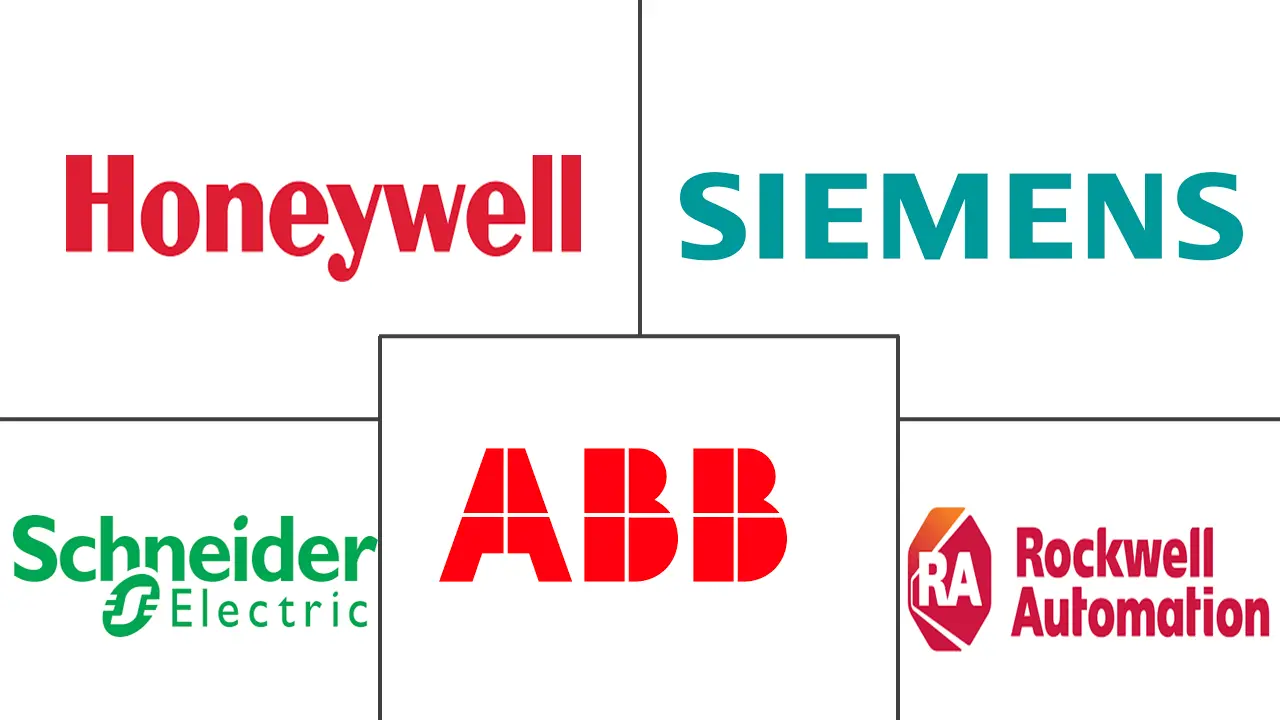
Analysis of Industry 4.0 Market by Mordor Intelligence
The Industry 4.0 market stands at USD 260.4 billion in 2025 and, on current momentum, is set to reach USD 747.4 billion by 2030, advancing at a steady 23.48% CAGR. Demand is shifting from stand-alone automation toward connected digital value chains that make factories more responsive, predictable, and resource-efficient. Artificial intelligence, industrial IoT, and edge computing work together to shorten maintenance windows, align supply with demand, and unlock new service revenue streams. Regional industrial policy, growing robotics density, and expanding private-5G coverage keep adoption budgets healthy even as manufacturers guard cash. Integration complexity is giving software platforms and systems integrators a larger share of project value, while security and ROI perception shape the pace of roll-outs among smaller suppliers.
Key Report Takeaways
- By end-user industry, manufacturing retained 34% of Industry 4.0 technologies market share in 2024, whereas healthcare and pharmaceuticals are forecast to compound at 23.60% through 2030.
- By technology type, industry automation led with a 40.20% revenue share in 2024; blockchain is projected to expand at a 28.40% CAGR to 2030.
- By component, software platforms captured 52% of the Industry 4.0 technologies market size in 2024, while services are advancing at a 25.10% CAGR as integration depth grows.
- By deployment model, on-premises accounted for 58% of the Industry 4.0 technologies market size in 2024; cloud deployments are expected to climb at 24.30% CAGR through 2030 as cybersecurity standards mature.
- By geography, North America led with 36.10% revenue share in 2024, backed by USD 33 million in federal smart-manufacturing grants and more than USD 9 billion in private acquisition spending [1]U.S. Department of Energy, “$33 Million in Funding Available to Advance Smart Manufacturing Technologies,” energy.gov.
Insights and Trends of Industry 4.0 Market
Drivers Impact Analysis
| Drivers | (%) Impact on CAGR Forecast | Geographic Relevance | Impact Timeline |
|---|---|---|---|
| Favorable governmental initiatives and multi-stakeholder collaborations | +4.2% | EU, China, North America | Medium term (2-4 years) |
| Surging demand for industrial and collaborative robotics | +3.8% | Global; highest in APAC hubs | Short term (≤ 2 years) |
| Rapid SME-led digital transformation programs | +2.9% | North America, EU; expanding to emerging markets | Medium term (2-4 years) |
| Edge/private 5G roll-outs enabling ultra-low-latency factory networks | +2.1% | APAC core, spill-over to North America and EU | Long term (≥ 4 years) |
| Decarbonisation premiums for smart-energy, self-optimising plants | +1.2% | Strong in EU, UK, US, and East Asia (Japan, South Korea, China); emerging in India and Middle East | 2025–2035 (Mid to Long-term) |
| AI-powered generative design reducing prototyping time and cost | +0.8% | High in North America, Europe, East Asia | Near to Mid-term (2025–2030) |
| Source: Mordor Intelligence | |||
Favorable Governmental Initiatives and Multi-Stakeholder Collaborations
Public funding and cross-industry alliances are de-risking first-mover adoption across the Industry 4.0 technologies market. The EU has earmarked EUR 584 billion (USD 637 billion) for grid digitalization, creating open data standards that manufacturers can tap for energy and logistics optimization. China’s Manufacturing Innovation Centers program has launched 33 dedicated facilities that fast-track semiconductor, robotics, and EV breakthroughs Germany’s Manufacturing-X network already links 95% of local industrial firms through shared data layers, and 42% of those enterprises are running AI directly on the shop floor. These policies shorten proof-of-concept cycles, lower integration risk, and accelerate supplier onboarding, lifting overall technology uptake.
Surging Demand for Industrial and Collaborative Robotics
Cobot installations are rising on the back of falling sensor prices, simpler safety certification, and acute labor shortages. Worldwide cobot revenue could jump from USD 970 million in 2023 to USD 7.2 billion by 2030 as applications move from automotive to electronics and logistics [3]International Federation of Robotics, “Collaborative Robots – How Robots Work alongside Humans,” ifr.org. Japanese factory automation expenditure is tracking a rise from USD 15.1 billion in 2024 to USD 35.2 billion by 2033, reflecting demographic pressures on precision industries. Machine-learning-enabled cobots cut redeployment effort and shrink engineering hours, putting smaller batch runs within reach and widening the customer base across mid-tier manufacturers.
Rapid SME-Led Digital Transformation Programs
Small and medium enterprises are piloting sensor-centric projects that prove value in weeks rather than quarters. OECD reports show 72% of SMEs now use digital data for operational decisions, and 18% adopted generative AI inside twelve months of release. Germany’s Next-Level Mittelstand initiative lifts adoption rates by facilitating peer-to-peer learning, with SMEs citing a 40% faster ramp versus vendor-led programs. Cloud subscription models cut capex and give resource-constrained firms access to analytics previously reserved for large enterprises, intensifying competition and speeding ecosystem adoption.
Edge/Private 5G Roll-Outs Enabling Ultra-Low-Latency Factory Networks
Manufacturers are moving beyond pilot trials to full-scale private-5G deployments, with the 3.8-4.2 GHz spectrum allocation improving equipment availability and reducing license friction ericsson.. deployment at Jaguar Land Rover’s Solihull plant demonstrates sub-10 millisecond responsiveness for machine vision and autonomous carts.[2]Ericsson,“Ericsson Private 5G to Support JLR’s Digital Manufacturing Transformation,” ericsson.com Integration with local edge servers supports AI inference at the machine layer, insulating production from cloud outages and easing data-sovereignty concerns. Capital spending on private networks is expected to surpass USD 3.5 billion by 2027 as more sites prioritize flexible re-layout and wireless diagnostics.
Restraints Impact Analysis
| Restraint | (%) Impact on CAGR Forecast | Geographic Relevance | Impact Timeline |
|---|---|---|---|
| Uncertain ROI perception among Tier-2/3 suppliers | -2.4% | Global; strongest in SME-heavy regions | Short term (≤ 2 years) |
| Cyber-physical security liabilities and patch-management costs | -1.8% | Global; especially critical infrastructure sectors | Medium term (2-4 years) |
| Legacy-system interoperability bottlenecks | −1.3% | Mature manufacturing bases in EU, North America | Medium term (2-4 years) |
| Skilled-labor shortages for data science and OT security | −1.0% | Global; severe in emerging markets | Long term (≥ 4 years) |
| Source: Mordor Intelligence | |||
Uncertain ROI Perception Among Tier-2/3 Suppliers
Many mid-tier suppliers hesitate to commit capital when benefits are indirect or spread across the chain. An OECD survey of 840 enterprises in G7 countries places ROI worry as the top AI adoption barrier, with small firms lagging much larger peers. Thin margins restrict pilot scope, and the lack of data science talent raises transition risk. Food-and-beverage plants illustrate the gap: 44% cite cost as the key hurdle despite clear quality-control wins. Until financing models or service-based pricing reduce up-front spend, adoption by smaller enterprises will trail that of global tier-1 manufacturers.
Cyber-Physical Security Liabilities and Patch-Management Costs
Industrial networks now touch enterprise IT and public clouds, widening the attack surface. The Cyber4AM review of Irish manufacturing SMEs found consistent exposure to phishing, supply-chain compromise, and ransomware. CISA issued 20 industrial-control advisories in a single month of 2024, underscoring the breadth of vulnerabilities. Patching production systems while keeping lines running forces costly downtime windows or parallel system architectures. These hidden lifecycle expenses often inflate total cost of ownership and can delay, resize, or even cancel planned upgrades, particularly in resource-limited plants.
Segment Analysis
By Technology Type: Blockchain Disrupts Traditional Automation Hierarchies
Industry automation delivered 40.20% of 2024 revenue, anchoring the Industry 4.0 technologies market with PLCs, SCADA, and MES suites that underpin real-time control. In contrast, blockchain is forecast to increase at a 28.40% CAGR, propelled by proof-of-provenance mandates and the promise of frictionless smart contracts that cut transaction fees up to 50%. Industrial IoT roll-outs accelerate as sensor prices decline, feeding edge AI models that improve yield and lower scrap. Digital twin programs break beyond simulation, enabling additive-manufacturing validation through collaborative virtual reality.
Real-time analytics lock in process improvements, letting discrete manufacturers shift from mass production to mass customization. Vision-guided robotics and AR-supported maintenance open new value pools, especially when tied to private-5G backbones. As a result, the Industry 4.0 technologies market size attached to advanced analytics platforms is expected to grow more quickly than hardware spend. But integration hurdles persist: data silos, model-training cost, and divergent security standards can delay full benefits until vendor ecosystems converge on open APIs.
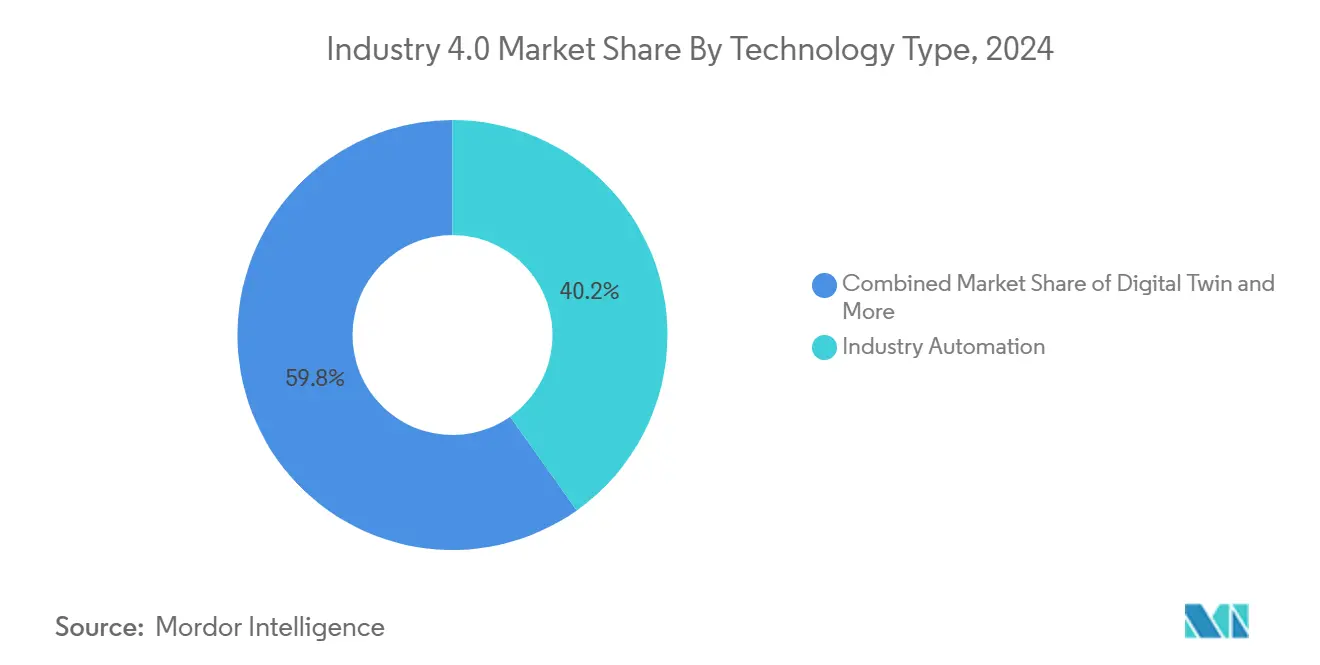
Note: Segment shares of all individual segments available upon report purchase
By Component: Services Growth Reflects Implementation Complexity
Software accounted for 52% of 2024 revenue, underscoring management’s push for actionable insights rather than more raw data. The services slice is advancing at 25.10% CAGR as plants seek system-integration partners capable of stitching legacy OT with modern cloud microservices. Industrial cybersecurity audits, workforce up-skilling, and continuous algorithm tuning drive recurring income that smooths vendor revenue beyond one-time licenses.
Hardware demand remains stable for sensors, industrial PCs, and smart drives. Yet value is migrating toward solution design and data stewardship. Providers that can wrap multi-vendor gateway hardware into outcome-based contracts are winning larger share of wallet. Over time, predictive-maintenance as-a-service and factory-analytics subscriptions can displace traditional capex as the dominant engagement model within the Industry 4.0 technologies market.
By Deployment Model: Cloud Adoption Accelerates Despite Security Concerns
On-premises control rooms held 58% in 2024, but cloud deployments are climbing at a 24.30% CAGR as zero-trust frameworks gain acceptance and as industry-specific sovereign-cloud offerings appear. Hybrid approaches dominate among global manufacturers who must balance sub-second control with corporate-wide analytics. Edge nodes filter and act on sensor data locally before synchronizing summaries to the cloud, keeping latency in check while enabling enterprise-scale machine learning.
Private-cloud builds appeal to firms in aerospace, defense, and pharma, each bound by strict compliance. Multi-cloud setups mitigate vendor lock-in and price spikes, especially when workloads can be rebalanced across platforms. Rising reliance on hyperscalers also shifts bargaining power; OEMs that combine domain know-how with cloud orchestration skills stand to capture differentiated margins.
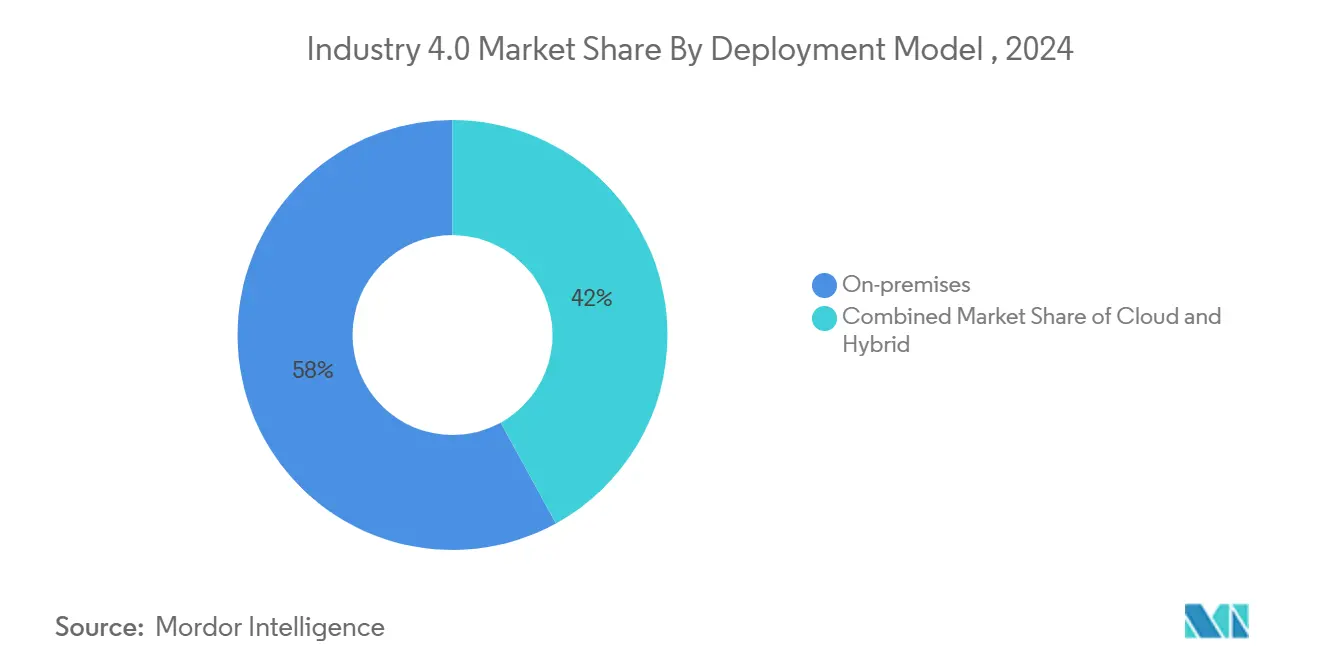
Note: Segment shares of all individual segments available upon report purchase
By End-User Industry: Healthcare Digitalization Outpaces Traditional Manufacturing
Manufacturing lines dominated revenue in 2024 with 34% but face a flattening curve as early movers approach saturation. Healthcare and pharmaceuticals are projected to compound at 23.60% owing to FDA validation pathways that favor AI-driven quality control and digital traceability. Oil and gas operators deploy IoT sensors for remote pipeline surveillance, and digital twins sharpen uptime on offshore rigs. Utilities invest in smart-grid technologies to hit decarbonization targets, weaving AI into distribution management to stabilize variable renewables.
Aerospace primes additive manufacturing for lightweight structures while applying blockchain to secure multi-tier supply chains. Food and beverage brands fold real-time quality sensors into packaging lines, guiding AI-driven demand planning that keeps waste low and freshness high. Logistics hubs integrate autonomous mobile robots and warehouse-execution software to trim order lead times. The broadening range of vertical templates expands total addressable demand for the Industry 4.0 technologies market and intensifies the race for domain-specific solutions.
Geography Analysis
North America generated 36.10% of global revenue in 2024, supported by USD 33 million in public funding awards and more than USD 9 billion worth of automation-focused M&A. An advanced installed base of sensors plus early cloud adoption accelerate multilayer platform build-outs. Canada leverages automotive electrification and cross-border supply chains, while Mexico exploits near-shoring tailwinds to weave smart-assembly capabilities into export plants. Private networks and industrial AI testbeds funded under Manufacturing USA continue to funnel best practices into mid-sized firms, enlarging the Industry 4.0 technologies market size addressed by domestic suppliers.
Asia-Pacific is the fastest growing territory at 25.80% CAGR through 2030. China had installed more than 290,000 industrial robots by 2022 and is scaling 33 Innovation Centers that fast-track breakthroughs in semiconductors and electric vehicles. India has earmarked USD 102 billion for Industry 4.0 adoption and is channeling one-fifth of its manufacturing tech budget into digital tools. Japan’s automation revenue is expected to more than double by 2033, reflecting labor-substitution priorities. South Korea’s USD 1.9 billion SME program further widens the regional customer base.
Europe sustains a robust pipeline of cross-border initiatives. The EUR 584 billion (USD 637 billion) grid-digitalization plan, together with Manufacturing-X, stitches micro-suppliers into shared data spaces that cut redundancy and standardize APIs. Surveys by VDMA show that 81% of companies already treat Industry 4.0 as an opportunity, and 71% are running at least one production-grade use case vdma.org. Middle East and Africa markets remain nascent but gain momentum through oil-and-gas digital twins and smart-city mega-projects that depend on resilient industrial control systems.
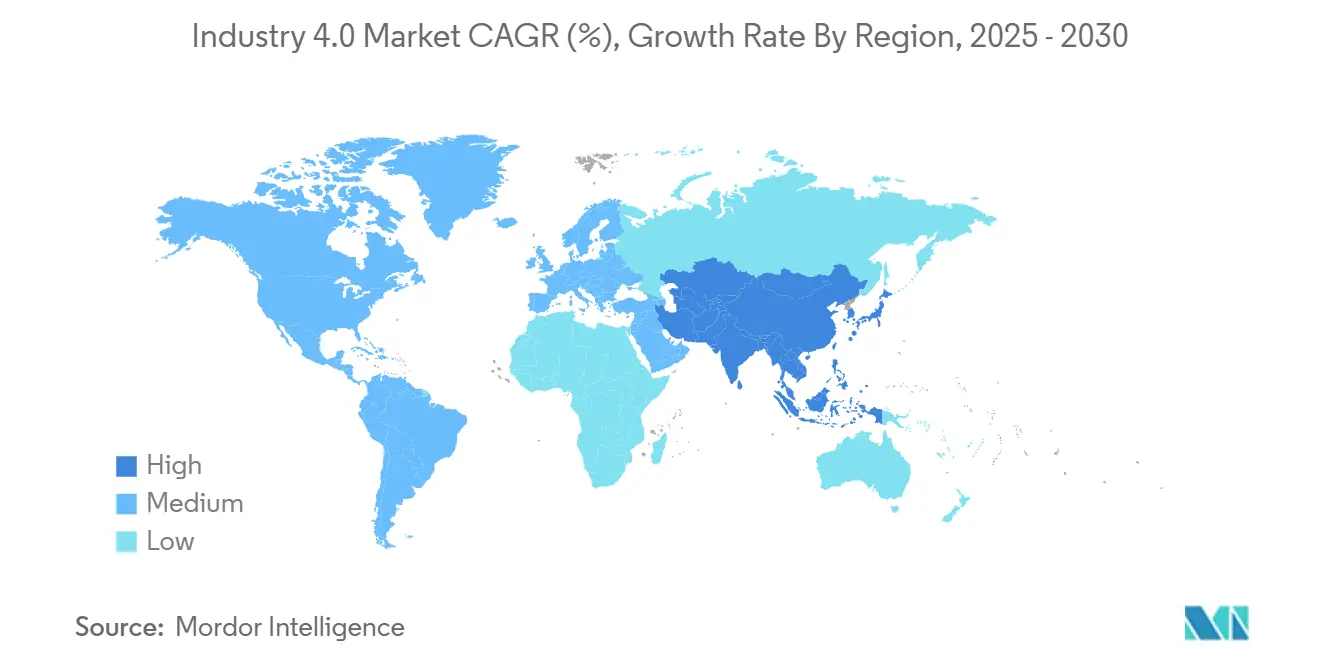
Competitive Landscape
Innovation and Adaptability Drive Future Success
The Industry 4.0 technologies market remains moderately fragmented. Legacy automation giants—Siemens, ABB, Schneider Electric—are layering software and services onto extensive installed bases. Siemens reported EUR 38.2 billion (USD 41.7 billion) in 2024 revenue and is projecting a Digital Industries recovery by fiscal 2026 despite macro softness. Cloud platforms from Microsoft and IBM are pushing down-market, offering pay-as-you-go AI that undercuts traditional perpetual licenses.
Strategic consolidation is accelerating. Emerson’s USD 11 billion purchase of Aspen Technology folds asset-optimization software into a controls portfolio, aiming to capture value at the analytics layer. Rockwell Automation’s stake in RightHand Robotics brings piece-picking AI to warehouse clients, broadening reach beyond plant-floor PLCs. Vendors are also teaming with telecom operators to co-develop edge-to-cloud reference stacks for private-5G campuses.
White-space opportunities revolve around industrial cybersecurity, domain-specific digital twins, and low-code orchestration frameworks. Startups with AI-first architectures often partner with system integrators rather than compete head-to-head, ensuring faster market access yet diluting direct revenue. Over the planning horizon, winners will be those that bundle hardware, software, and managed services into outcome-oriented contracts that guarantee throughput, quality, or energy savings.
Leaders of Industry 4.0 Market
-
ABB Ltd.
-
Siemens AG
-
Rockwell Automation Inc.
-
Schneider Electric SE
-
Honeywell International Inc.
- *Disclaimer: Major Players sorted in no particular order
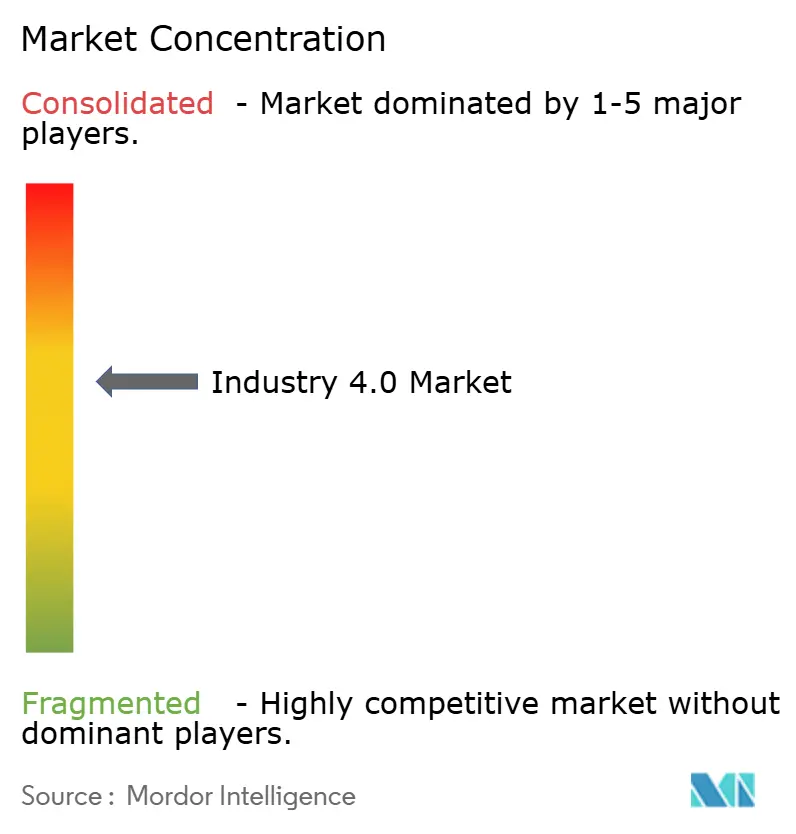
Recent Industry Developments
- March 2025: Rockwell Automation invested in RightHand Robotics to integrate robotic piece-picking with AutoStore ASRS and OTTO Motors AMRs, strengthening its logistics automation portfolio
- February 2025: Ericsson deployed private 5G at Jaguar Land Rover’s Solihull plant, enabling real-time IoT data and vision analytics under the UK-funded West Midlands 5G program
- January 2025: Emerson closed its USD 11 billion acquisition of Aspen Technology, positioning the combined firm for end-to-end industrial software leadership
- December 2024: SICK AG posted EUR 2,103 million (USD 2,295 million) in sales and filed 163 patents, 26 focused on industrial AI, underscoring a shift toward sensor-based analytics
Research Methodology Framework and Report Scope
Market Definitions and Key Coverage
Our study defines the Industry 4.0 market as the value of hardware, software platforms, and associated services that digitize factory-floor and supply-chain operations through industrial IoT, robotics, AI/ML analytics, digital twins, blockchain, extended reality, and additive manufacturing. Revenues are captured only when the technology is deployed inside production or logistics environments; pilot proofs of concept are counted once commercialized.
Scope exclusion: pure IT modernization projects that never interface with operational technology layers are kept outside this market.
Segmentation Overview
- By Technology Type
- Industrial Robotics
- Industrial Internet of Things (IIoT)
- Artificial Intelligence and Machine Learning
- Blockchain
- Extended Reality (AR/VR/MR)
- Digital Twin
- 3D Printing / Additive Manufacturing
- Edge Computing and Private 5G
- By Component
- Hardware
- Software / Platforms
- Services (Integration, Consulting, Support)
- By Deployment Model
- On-Premises
- Cloud
- Hybrid
- By End-user Industry
- Discrete Manufacturing
- Automotive
- Oil and Gas
- Energy and Utilities
- Electronics and Semiconductor Foundry
- Food and Beverage
- Aerospace and Defense
- Healthcare and Pharma
- Logistics and Warehousing
- By Geography
- North America
- United States
- Canada
- Mexico
- South America
- Brazil
- Argentina
- Rest of South America
- Europe
- Germany
- United Kingdom
- France
- Spain
- Russia
- Rest of Europe
- Asia Pacific
- China
- India
- Japan
- South Korea
- Rest of Asia Pacific
- Middle East and Africa
- GCC
- Turkey
- South Africa
- Rest of Middle East and Africa
- North America
Detailed Research Methodology and Data Validation
Primary Research
Mordor analysts complemented desk work with interviews and surveys covering plant managers, automation systems integrators, industrial software vendors, and regional policy bodies across North America, Europe, and Asia-Pacific. These conversations validated penetration rates, typical retrofit budgets, and forecast headwinds such as chip lead times and cyber security liabilities.
Desk Research
We begin with a wide desk scan that pulls structured statistics from tier-1 public sources such as the International Federation of Robotics, World Bank industrial value-added series, Eurostat's PRODCOM, United States Census Annual Survey of Manufactures, and WTO trade codes for industrial controllers. Company 10-Ks, investor decks, and selected patent families from Questel reveal adoption velocity and pricing inflections for sensors, cobots, and 3D-printing powders.
Next, our analysts cross-reference shipment logs from Volza, contract awards flagged by Tenders Info, and regional policy trackers (for example, Germany's "Industrie 4.0 Plattform") to size brownfield retrofit spending. These sources establish baselines for unit volumes, average selling prices, and installed-base churn. The list is indicative; many additional publications and datasets were mined to refine assumptions and close data gaps.
Market-Sizing & Forecasting
A top-down model converts global manufacturing output into an Industry 4.0 addressable spend pool, which is then aligned with technology-level adoption curves. Select bottom-up checks, supplier roll-ups and channel ASP × volume samples, are applied to calibrate totals before sign-off. Key variables include industrial robot density per 10,000 workers, IIoT node shipments, edge AI chipset ASPs, additive manufacturing powder consumption, and smart factory CAPEX ratios. Five-year projections employ a multivariate regression that blends manufacturing PMI trends, corporate CAPEX outlooks, and government incentive pipelines, with coefficients reviewed by our primary experts.
Data Validation & Update Cycle
Outputs face a three-tier peer review, variance tests against external macro and micro indicators, and anomaly callbacks to expert respondents. Mordor refreshes each dataset annually, issuing mid-cycle amendments when material events, such as major fiscal incentives or supply shocks, shift the underlying series.
Why Mordor's Industry 4.0 Baseline Is the Dependable Compass
Published estimates do vary, largely because firms mix consumer IoT, generic IT services, or standalone analytics tools into their totals, and because refresh cadences range from quarterly to multi-year cycles.
Key gap drivers include differing inclusion of pilot projects, diverging ASP deflators, and whether services linked to legacy SCADA upgrades are counted. Mordor's disciplined boundary setting, yearly model rebuild, and dual-angle validation remove these distortions.
Benchmark comparison
| Market Size | Anonymized source | Primary gap driver |
|---|---|---|
| USD 260.4 B (2025) | Mordor Intelligence | - |
| USD 190.9 B (2025) | Global Consultancy A | Excludes managed services and digital twin software; uses lower ASP benchmarks |
| USD 200.1 B (2024) | Trade Publication B | Counts only hardware; adjusts currency at fixed 2021 rates |
| USD 551.7 B (2024) | Research Boutique C | Adds generic cloud and enterprise analytics spend; no adoption rate filters |
These comparisons show how scope breadth, pricing assumptions, and update timing alter totals. By anchoring figures to clear operational technology boundaries and regularly re-testing inputs, Mordor delivers a balanced, transparent baseline that decision-makers can replicate and trust.
Key Questions Answered in the Report
What is the current size of the Industry 4.0 technologies market?
The Industry 4.0 technologies market size is USD 260.4 billion in 2025 and is projected to hit USD 747.4 billion by 2030.
Which segment is growing the fastest within Industry 4.0 projects?
Blockchain applications show the highest growth, poised to expand at a 28.40% CAGR through 2030 as manufacturers demand transparent and automated supply chains.
Why are SMEs important to Industry 4.0 adoption?
SMEs account for a large share of manufacturing output; modular cloud tools and peer-learning programs are pushing their digital transformation, lifting ecosystem adoption rates by up to 40%.
How significant are private-5G networks for smart factories?
Private-5G ensures sub-10 millisecond latency, allowing mobile robots and vision systems to operate wirelessly and reliably, which unlocks flexible plant layouts and safer human-robot collaboration.
What key risks slow Industry 4.0 deployment?
Uncertain ROI for tier-2/3 suppliers and heightened cyber-physical security liabilities increase project payback periods and can delay roll-outs, particularly in cash-constrained plants.
Page last updated on:
